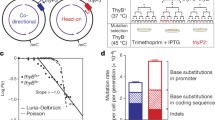Abstract
We have previously shown that concurrent progression of pBR322 replication and pTac-directed transcription in opposite orientations induces illegitimate recombination events. We tested here the effects of M13 rolling circle replication on the incidence of plasmid deletions. The progression of the M13 replication fork leads to an increase of more than 300-fold in the frequency of transcription-dependent deletion events. pBR322 derivatives carrying the M13 replication origin and a 511 bp transcribed region under the control of the pTac promoter were used. Up to 12% of the plasmid population has sustained deletions within 4 h following the induction of pTac-directed transcription and M13 DNA replication, provided that the two proceed in opposite orientations. We observed that induction of transcription of the wholeEscherichia coli lacZ gene (3244 bp) in the direction opposite to M13 replication leads to a fivefold decrease in plasmid copy number within 2 h, which is consistent with the proposal that deletions arise because replication fork progression is impeded. This decrease in parental plasmid copy number leads in turn to an enrichment in deleted plasmid forms. Our data confirm and extend the notion that simultaneous transcription and replication in opposite directions can efficiently promote deletion formation. In addition, this instability may be amplified when the rearranged molecules acquire a replicative advantage.
Similar content being viewed by others
References
Bierne H, Michel B (1994) When replication forks stop. Mol Microbiol 13:17–23
Bierne H, Ehrlich SD, Michel B (1991) The replication termination signalTerB of theEscherichia coli chromosome is a deletion hot spot. EMBO J 10:2699–2705
Bierne H, Ehrlich SD, Michel B (1995) Competition between parental and recombinant plasmids affects the measure of recombination frequencies. Plasmid 33:101–112
Casadaban MJ, Cohen SN (1980) Analysis of gene control signals by DNA fusion and cloning inEscherichia coli. J Mol Biol 138:179–207
French S (1992) Consequences of replication fork movement through transcription units in vivo. Science 258:1362–1365
Geider K, Hohmeyer C, Haas R, Meyer TF (1985) A plasmid cloning system utilizing replication and packaging functions of the filamentous bacteriophage fd. Gene 33:341–349
Horiuchi T, Fujimura Y (1995) Recombinational rescue of the stalled DNA replication fork: a model based on analysis of anEscherichia coli strain with a chromosome region difficult to replicate. J Bacteriol 177:783–791
Kuzminov A, (1995) Instability of inhibited replication forks inEscherichia coli. Bio Essays 17:733–741
Liu B, Alberts BM (1995) Head-on collision between a DNA replication apparatus and RNA polymerase transcription complex. Science 267:1131–1137
Mazin A, Timchenko T, Saparbaev MK, Mazina OM (1996) Dimerization of plasmid DNA accelerates selection for antibiotic resistance. Mol Microbiol 20:101–108
Takahashi S, Hours C, Iwaya M, Lane HE, Denhardt DT (1978) TheEscherichia coli rep gene. In: Denhardt DT, Dressler D, Ray DS (eds) The single-stranded DNA phages. Cold Spring Harbor Laboratory press, Cold Spring Harbor, New York, pp 393–400
te Riele H, Michel B, Ehrlich SD (1986) Are single-stranded circles intermediates in plasmid DNA replication? EMBO J 5:631–637
Uzest M, Ehrlich SD, Michel B (1991) TheEscherichia coli TerB sequence affects the maintenance of plasmid with the M13 phage replication origin. J Bacteriol 173:7695–7697
Vilette D, Uzest M, Ehrlich SD, Michel B (1992) DNA transcription and repressor binding affect deletion formation inEscherichia coli plasmids. EMBO J 11:3629–3634
Vilette D, Ehrlich SD, Michel B (1995) Transcription-induced deletions inEscherichia coli plasmids. Mol Microbiol 17:493–504
Warren G, Sherratt D (1978) Incompatibility and transforming efficiency of ColE1 and related plasmids. Mol Gen Genet 161:39–47
Author information
Authors and Affiliations
Additional information
Communicated by R. Devoret
Rights and permissions
About this article
Cite this article
Vilette, D., Ehrlich, S.D. & Michel, B. Transcription-induced deletions in plasmid vectors: M13 DNA replication as a source of instability. Molec. Gen. Genet. 252, 398–403 (1996). https://doi.org/10.1007/BF02173004
Received:
Accepted:
Issue Date:
DOI: https://doi.org/10.1007/BF02173004




